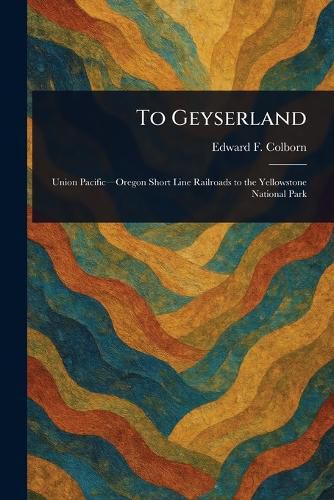Readings Newsletter
Become a Readings Member to make your shopping experience even easier.
Sign in or sign up for free!
You’re not far away from qualifying for FREE standard shipping within Australia
You’ve qualified for FREE standard shipping within Australia
The cart is loading…






This title is printed to order. This book may have been self-published. If so, we cannot guarantee the quality of the content. In the main most books will have gone through the editing process however some may not. We therefore suggest that you be aware of this before ordering this book. If in doubt check either the author or publisher’s details as we are unable to accept any returns unless they are faulty. Please contact us if you have any questions.
"To Geyserland: Union Pacific-Oregon Short Line Railroads to the Yellowstone National Park" is a historical travel guide to the wonders of early Yellowstone National Park. Written by Edward F. Colborn, this meticulously prepared print edition offers a glimpse into the park's famous geysers and stunning landscapes, as experienced by travelers of the late 19th and early 20th centuries.
Explore the park through the lens of the Union Pacific and Oregon Short Line Railroads, the vital arteries that brought tourists to "Geyserland." This book provides insight into the journey itself, offering a snapshot of a bygone era of travel and exploration. Discover the allure of Yellowstone that captivated visitors then and continues to inspire awe today. A valuable resource for anyone interested in the history of Yellowstone, the American West, and early tourism.
This work has been selected by scholars as being culturally important, and is part of the knowledge base of civilization as we know it.
This work is in the public domain in the United States of America, and possibly other nations. Within the United States, you may freely copy and distribute this work, as no entity (individual or corporate) has a copyright on the body of the work.
Scholars believe, and we concur, that this work is important enough to be preserved, reproduced, and made generally available to the public. We appreciate your support of the preservation process, and thank you for being an important part of keeping this knowledge alive and relevant.
$9.00 standard shipping within Australia
FREE standard shipping within Australia for orders over $100.00
Express & International shipping calculated at checkout
This title is printed to order. This book may have been self-published. If so, we cannot guarantee the quality of the content. In the main most books will have gone through the editing process however some may not. We therefore suggest that you be aware of this before ordering this book. If in doubt check either the author or publisher’s details as we are unable to accept any returns unless they are faulty. Please contact us if you have any questions.
"To Geyserland: Union Pacific-Oregon Short Line Railroads to the Yellowstone National Park" is a historical travel guide to the wonders of early Yellowstone National Park. Written by Edward F. Colborn, this meticulously prepared print edition offers a glimpse into the park's famous geysers and stunning landscapes, as experienced by travelers of the late 19th and early 20th centuries.
Explore the park through the lens of the Union Pacific and Oregon Short Line Railroads, the vital arteries that brought tourists to "Geyserland." This book provides insight into the journey itself, offering a snapshot of a bygone era of travel and exploration. Discover the allure of Yellowstone that captivated visitors then and continues to inspire awe today. A valuable resource for anyone interested in the history of Yellowstone, the American West, and early tourism.
This work has been selected by scholars as being culturally important, and is part of the knowledge base of civilization as we know it.
This work is in the public domain in the United States of America, and possibly other nations. Within the United States, you may freely copy and distribute this work, as no entity (individual or corporate) has a copyright on the body of the work.
Scholars believe, and we concur, that this work is important enough to be preserved, reproduced, and made generally available to the public. We appreciate your support of the preservation process, and thank you for being an important part of keeping this knowledge alive and relevant.